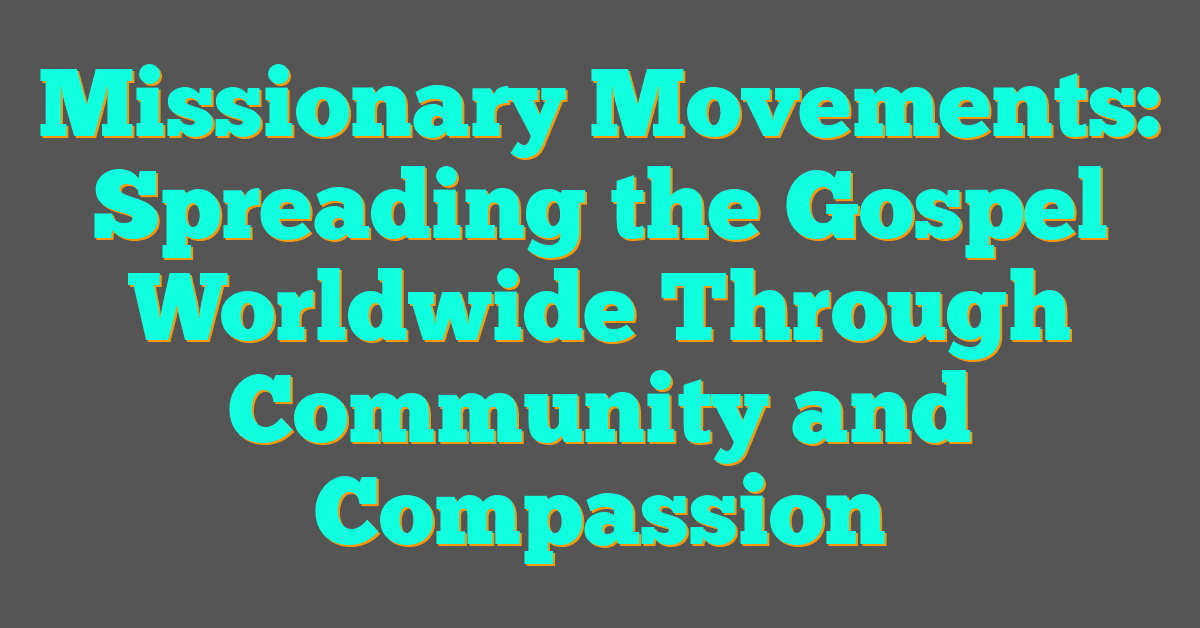Missionary movements have played a crucial role in spreading the gospel and shaping Christianity around the world. These efforts date back centuries and continue to evolve today.
Through dedicated individuals and organizations, the message of Christ reaches diverse cultures, fostering faith and community across the globe.

Many key figures have emerged throughout history, driven by a passion to share their beliefs. Their commitment and strategies have adapted to the needs of different regions and societies.
As the world becomes more interconnected, the impact of missionary work is more significant than ever, uniting people through shared values and hope.

In examining these movements, it’s clear that they are not just about evangelism. They also seek to address social issues and contribute positively to communities. Understanding these efforts provides a deeper insight into how faith can transform lives and cultures worldwide.
Key Takeaways
- Missionary movements help spread the gospel by sharing faith across different cultures.
- Key figures and organizations adapt their approach to meet the needs of various communities.
- The impact of missionaries includes addressing social issues and building stronger communities.
Historical Context of Missionary Movements
Missionary movements have deep roots in Christian history, driven by a desire to share the gospel and spread faith across the world. Each period brought distinct developments that shaped the way the Christian message was communicated, from the early church to modern times.
The Great Commission and Early Church Missions
The Great Commission, found in the New Testament, is a pivotal moment in Christianity. Jesus instructed his disciples to go forth and make disciples of all nations. This directive set the stage for early church missions.
Following this command, early Christians traveled extensively, establishing communities and sharing the gospel. They focused on urban centers like Antioch and Corinth, where diverse populations offered many opportunities for evangelism.
These early missions were characterized by a grassroots approach, relying on personal relationships. It was less about institutional support and more about individuals passionately spreading their faith.
Reformation and the Missionary Impulse
The Reformation in the 16th century sparked significant changes in how the church viewed missions. Leaders like Martin Luther and John Calvin emphasized scripture’s importance and encouraged believers to actively share their faith.
This period saw the rise of religious groups that prioritized evangelism. The Protestant movement started to view missions as essential to the faith, leading to the establishment of various societies aimed at sharing the gospel.
John Wesley, a key figure in the Methodist movement, revived the emphasis on personal evangelism. He encouraged believers to be active in their communities, promoting spiritual awakening and outreach.
Modern Missions and the Great Awakenings
The 18th and 19th centuries marked a new era in missionary work, driven by the Great Awakenings. These spiritual awakenings ignited a zeal for evangelism, pushing Christians to engage in active mission work.

Many Christians felt called to spread the gospel beyond their local areas. Mission societies formed, sending missionaries to Asia, Africa, and the Americas.
During this time, various tools and strategies emerged to enhance missionary efforts. Literature, education, and health care became methods to engage with communities.
Missionaries sought to address both spiritual and physical needs, working tirelessly to share the message of hope and salvation.
Key Missionary Figures and Movements
Missionary movements have played a vital role in spreading the Christian faith across the globe. Various key figures have made significant contributions to these movements, each leaving a unique legacy.
William Carey and the Birth of Modern Missions
William Carey is often called the father of modern missions. In the late 18th century, he made a compelling case for evangelism beyond Europe. He believed Christians should take the gospel to all nations.
In 1793, he traveled to India and faced many challenges, including cultural differences and opposition. Despite this, he founded the Serampore College and started translating the Bible into multiple languages. Carey’s efforts laid the groundwork for future missionary activities and inspired others to engage in missions.
David Brainerd and the American Missionary Movement
David Brainerd was an influential figure in the American missionary movement during the 18th century. His commitment to evangelizing Native Americans set a remarkable example for future missionaries.
Brainerd faced numerous hardships, including illness and isolation. Still, he persevered, documenting his experiences in a journal that inspired many. His focus on prayer and personal piety became key themes in American missions.
Through his work, Brainerd ignited interest in missions to Indigenous peoples, leading to increased efforts by various denominations.
Hudson Taylor and the China Inland Mission

Hudson Taylor significantly impacted missionary work in China during the 19th century. He founded the China Inland Mission in 1865, which aimed to reach areas of China that were less familiar with Christianity.
Taylor adopted Chinese customs and dress to connect better with the population. His approach broke barriers and inspired many missionaries to engage more deeply with local cultures. He emphasized the importance of prayer and faith in overcoming challenges.
Taylor’s work greatly expanded the reach of Christianity in China and had lasting effects on subsequent missionary movements.
Other Influential Missionaries and Their Legacies
Many other missionaries made important contributions. For example, Adoniram Judson was the first American missionary to Burma. He translated the Bible into Burmese and advocated for religious freedom.
Another notable figure is William Miller, known for his work in the Second Great Awakening, which fueled interest in missions.

These missionaries, along with Carey, Brainerd, and Taylor, helped shape the landscape of global evangelism. Their legacies continue to inspire new generations of missionaries today.
Understanding Mission Theology
Mission theology focuses on the principles that guide evangelical efforts around the world. It emphasizes the Holy Spirit’s role, the biblical roots of missions, and the concept of the Kingdom of God.
The Role of the Holy Spirit in Missions
The Holy Spirit is essential in missions. He empowers believers, guiding them in their evangelization efforts. This spiritual support helps missionaries share the gospel with confidence and clarity.
The Holy Spirit also convicts hearts, leading individuals toward salvation. This divine influence shapes the mission strategy, ensuring that the message resonates deeply. Missionaries often rely on prayer to seek the Spirit’s guidance for their paths.

Being attuned to the Holy Spirit allows missionaries to adapt their methods. They can respond to needs in diverse cultures while remaining true to biblical teachings.
Biblical Foundations for Global Missions
Scripture provides a strong foundation for missions. In Matthew 28:19-20, Jesus commands His followers to make disciples of all nations. This Great Commission underlines the importance of spreading the message of salvation.
The Bible also highlights various mission themes, such as God’s heart for all people. John 3:16 states that God loves the world and desires everyone to experience salvation.
Key figures in the Bible served as examples for missionaries. The apostles, especially Paul, traveled extensively, sharing the gospel. Their commitment illustrates how believers can participate in global missions today.
The Kingdom of God as a Missionary Concept
The Kingdom of God represents an essential aspect of missionary work. It embodies God’s rule and reign over creation, inviting all people to experience His grace. Missionaries proclaim this message while emphasizing its transformative power.

When the Kingdom of God is active, it brings hope and restoration. This concept encourages believers to engage with communities, addressing spiritual and physical needs.
Missionaries often promote social justice as part of their mission. By living out Kingdom values, they demonstrate God’s love to others. Through evangelization, they seek not just spiritual growth but holistic community transformation.
The Modern Landscape of Mission Work
The landscape of mission work today is ever-changing. It reflects new perspectives on culture and faith while embracing local believers’ voices. This shift encourages more effective outreach methods and deeper connections within communities.
From ‘Heathen’ to ‘Unreached Peoples’: Shifting Paradigms
Traditionally, missionaries viewed those outside Christianity as “heathen.” This term carried a negative connotation, often implying a lack of understanding or acceptance of faith. Recently, many have shifted this perspective to focus on “unreached peoples.”

This change emphasizes respect and acknowledges the diversity in cultures. It recognizes the importance of understanding different worldviews. By moving away from pejorative terms, mission work can foster genuine dialogue and relationships.
Organizations now prioritize reaching groups without established Christian communities. They seek to learn from these cultures rather than impose beliefs. This approach generates more meaningful connections and enhances the impact of evangelization.
Indigenization and the Empowerment of Local Believers
Indigenization refers to the process where local believers take ownership of their faith. Rather than relying solely on foreign missionaries, local leaders guide their communities in spiritual matters. This shift is crucial for sustainable growth in the church.
Empowering local believers helps create a faith that resonates with their culture. Instead of a one-size-fits-all approach, mission work adapts to community needs. This method encourages local initiative and leadership.
As indigenous churches grow, they often develop unique expressions of faith. These expressions reflect their cultural identities while staying true to core Christian beliefs. This blend strengthens community ties and enhances the effectiveness of world evangelization.
The Role of Technology and Media in Spreading the Gospel

Technology plays a vital role in modern mission work. The internet and social media have transformed how churches reach new believers. Missionaries can now connect with people across the globe instantly.
Digital resources, like videos, podcasts, and online training, make faith accessible. They allow individuals in remote areas to engage with the gospel. This accessibility is especially important for unreached peoples who might not have direct access to churches.
Furthermore, social media fosters community and support among believers. It encourages sharing personal testimonies and insights. These tools can bridge cultural gaps and create awareness about different faith journeys. Technology proves to be a valuable asset in advancing mission work worldwide.
Missions in Practice
Missions involve a blend of strategies, worship, and awareness of challenges. Each aspect plays a crucial role in effective evangelism and the spread of the gospel around the world.
Strategies and Methods for Effective Evangelism

Successful evangelism often utilizes diverse strategies. Missionaries focus on building relationships within communities. This connection helps them understand local cultures and needs.
Common methods include:
- Community Service: Helping with local projects builds trust and opens doors for sharing the gospel.
- Discipleship Training: Educating new believers helps them grow in faith and share it with others.
- Using Technology: Social media and other online platforms can reach people far beyond traditional mission fields.
By using these methods, missionaries can effectively engage with people and share their faith.
Worship and Prayer as Tools for Missions
Worship and prayer are vital in missions. They provide strength and guidance for missionaries. Many groups begin their mission efforts with prayer, asking for wisdom and protection.
Worship activities may include:
- Local Gatherings: Bringing together community members to celebrate faith encourages unity.
- Prayer Walks: Missionaries often pray while walking through neighborhoods, inviting a spiritual presence.

Prayer not only supports individual missionaries but also lifts up entire communities in their journeys towards faith.
Challenges and Controversies in Modern Missions
Modern missions face several challenges. Cultural sensitivity is crucial to avoid misunderstandings. Some critics argue that mission work can resemble colonialism. They fear it may impose beliefs on vulnerable populations.
Other challenges include:
- Language Barriers: Communication is key for effective evangelism. Learning local languages can enhance relationships.
- Logistical Issues: Limited resources and unsafe areas can hinder outreach efforts.
Addressing these challenges requires careful planning and an open mind. Missionaries strive to respect local traditions while sharing their message.
Regional Focus in Missionary Work
Missionary work has taken different forms across various regions. Each area has unique challenges and opportunities. Understanding the focus of missions in these regions helps provide insights into their impact and ongoing efforts.
Missions in Latin America
Latin America has become an important region for missionary work. Many organizations send missionaries to share the gospel and provide community services. The region faces social issues such as poverty and inequality.
Missionaries often focus on both spiritual and practical needs. They engage in education, healthcare, and job training. The combination of spiritual teaching and tangible aid attracts many people. Churches in countries like Brazil and Colombia grow as a result of these efforts.
Latino communities in the U.S. also see a rise in mission initiatives aimed at connecting immigrants with their spiritual roots. This cultural exchange enriches both the missionaries and the communities they serve.
North American Missions: Trends and Developments
In North America, missionary work has shifted in recent years. Many churches are now focusing on local missions instead of international projects. They seek to address needs within their own cities first.
Emerging trends involve partnerships between churches and local organizations. These collaborations allow for more effective outreach. They also help fund community projects and support structures.
Missionaries in North America often emphasize building relationships. This strategy fosters trust and opens doors for sharing faith. Short-term missions are popular, providing young people chances to serve locally and gain experience.
The Impact of Revival Movements in Global Missions
Revival movements have historically played a key role in global missions. These movements bring renewed energy and focus to evangelism. They often lead to growth in church attendance and increased interest in faith.
In the 18th and 19th centuries, movements like the Great Awakening sparked missionary zeal. Today, similar revivals continue to inspire individuals to engage in missions worldwide.
Churches focus on prayer, worship, and community service, which energize local believers. This renewed passion often leads to outreach in both local and international contexts.
Revival has shown that by focusing on spiritual renewal, missionaries can effectively spread the gospel beyond borders.
Case Study: The Missionary Movement in Ecuador
Ecuador offers a noteworthy example of successful missionary work. The country has a rich cultural heritage and diverse population, including many indigenous groups.
Missionaries here often engage in community development alongside evangelism. They build schools, provide healthcare, and offer vocational training. These contributions help improve the quality of life while sharing the gospel.
The impact is evident in the growing number of local churches. Many Ecuadorians are now involved in mission efforts within their country and abroad.
This case study highlights the importance of culturally sensitive approaches in missionary work. By understanding and respecting local traditions, missionaries can build trust and make a meaningful impact.
Organization and Support of Mission Work
Mission work relies on various organizations, institutions, and funding sources. These groups play a critical role in mobilizing resources, training individuals, and supporting global outreach efforts.
Mission-Supporting Entities: Intervarsity, Cru, and Others
Intervarsity and Cru are two prominent organizations that support mission work. Intervarsity focuses on college students, providing resources and community to help them grow in their faith. They encourage students to engage in local and global missions through various programs.
Cru, formerly Campus Crusade for Christ, reaches out to students on campuses worldwide. It helps in mobilizing students to become active missionaries. Both organizations promote training, events, and initiatives that connect young people to mission opportunities.
Other organizations, like the World Gospel Mission and Pioneers, also assist in sending missionaries to diverse regions where the gospel is less known. These entities prioritize partnerships with local churches to ensure effective outreach.
Educational Institutions and Mission Training
Many colleges and training centers offer programs specifically designed for mission work. These institutions provide theological education, cross-cultural studies, and practical skills necessary for missionaries.
For example, some universities have partnerships with organizations such as Cru and Intervarsity to create mission-focused courses.
Students learn not just about religion but also about global cultures and communication. Additionally, mission training retreats are organized to develop personal skills in prayer, evangelism, and community building. This education prepares individuals to face challenges in various mission fields effectively.
Financing Missions: The Role of Commerce and Donors
Financing is crucial for mission work. Donations from individuals, churches, and organizations play a significant role in supporting missionaries and their efforts worldwide.
Furthermore, some organizations explore commercial avenues to fund their missions.
For instance, businesses may sponsor mission projects, providing funding and resources in exchange for community engagement. This model helps cover costs while enhancing the mission’s impact.
Donors are encouraged through different campaigns, awareness events, and the clear presentation of mission needs. The effectiveness of these finance strategies ensures that more missionaries can be sent out, reaching communities that need the gospel.
Missions and Society
Missions play a vital role in shaping societies and cultures. They involve the active spread of the Christian faith, while also responding to various societal changes. The impact of missions can be seen across cultural practices, the rise of secular ideas, and the increasing urgency for missionary work.
Influence of Missions on Society and Culture
Missions have significantly influenced many cultures around the world. They often promote education, health care, and social justice. This outreach can lead to improved living standards and greater community cohesion.
Through organizations like the Society for Promoting Christian Knowledge, missions have helped establish schools and hospitals. These institutions serve as beacons of hope, providing services that improve quality of life.
In some areas, missions have resulted in cultural exchanges. They encourage understanding between different traditions and lifestyles, fostering peace and collaboration.
Christian Missions and Secular Humanism
In a world where secular humanism is growing, Christian missions face unique challenges. Secular humanism often emphasizes human reason and ethics over religious beliefs.
This shift can create tension between traditional values and modern societal views. As a result, missions must find ways to engage respectfully with diverse worldviews. They need to communicate the relevance of the Christian faith in today’s context.
Missions often emphasize the importance of compassion and service. This approach can resonate with secular audiences, showing common ground in the pursuit of human dignity.
The Urgency of the Missionary Task in a Changing World
The world is changing rapidly due to technological advances and globalization. This change increases the urgency for missions to act.
Societies face challenges like poverty, injustice, and displacement. Missionaries are called to respond to these pressing issues by sharing hope and support.
The Great Commission inspires missionaries to spread the gospel, reminding them of their role in improving the world. As they address contemporary issues, missionaries actively demonstrate the relevance of their faith in practical ways.
Youth and Missions
Youth play a vital role in missionary movements, driving evangelism and global missions. Their enthusiasm and fresh perspectives can ignite change in communities worldwide. Understanding how to effectively engage this age group is essential for the future of missions.
Student Volunteer Movement and College Campus Ministry
The Student Volunteer Movement (SVM) began in the early 20th century. It urged students to consider missions and global service as a calling.
Today, many colleges witness similar movements through campus ministries that foster spiritual growth and mission awareness.
Programs like these provide resources, mentorship, and opportunities for students. They facilitate connections with mission organizations. This hands-on approach allows youth to explore their faith and its impact on the world.
Engaging the Next Generation in Missions
Engaging youth in missions requires creativity and relevance. Programs must address the spiritual needs of young people. They should emphasize real-life applications of faith through service, learning, and advocacy.
Experiences such as mission trips and volunteer opportunities allow youth to see the importance of their roles. These activities enable them to interact with diverse cultures and communities. By understanding different perspectives, young people can develop a deeper empathy for others.
Christian Conferences and Global Mission Awareness
Christian conferences often serve as platforms for raising awareness about global missions. Events like these invite youth to participate in discussions, workshops, and networking opportunities. They foster a sense of community and purpose among attendees.
Through speakers and interactive sessions, young people learn about pressing global issues. They discover how their faith can intersect with world challenges, such as poverty and conflict. Overall, these conferences inspire participants to take action and consider their roles in spreading the gospel.
The Future of Missionary Movements
The future of missionary movements is evolving with new trends and innovative strategies. Understanding these changes is vital for anyone interested in world evangelization and global outreach.
Trends and Predictions for World Evangelization
One significant trend is the growing emphasis on local leaders in missionary work. Organizations recognize that indigenous believers can connect better with their communities. This shift encourages sustainable growth and cultural relevance.
Digital evangelism is also gaining traction. With the rise of social media, missionaries can reach people globally with just a click. This method allows for targeted outreach and fosters real-time engagement.
Another trend is the focus on collaborative missions. Different groups are pooling resources and sharing ideas to tackle barriers in evangelism. This approach helps to maximize impact and build stronger networks.
Innovations and New Approaches to Missions
Innovations in technology are transforming missionary work. Tools like mobile apps and online training programs help missionaries learn new skills quickly. These resources enable them to adapt their methods to various contexts.
Crowdsourcing funds for missionary projects is becoming common. Many organizations use platforms to gather financial support from around the world. This method empowers individuals to contribute directly to projects they care about.
Creative outreach methods are also emerging. From creative arts to community service, missionaries are finding new ways to engage people. These approaches not only share the gospel but also build relationships within local communities.
These trends and innovations shape the landscape of missionary movements, making evangelism more effective and meaningful.














